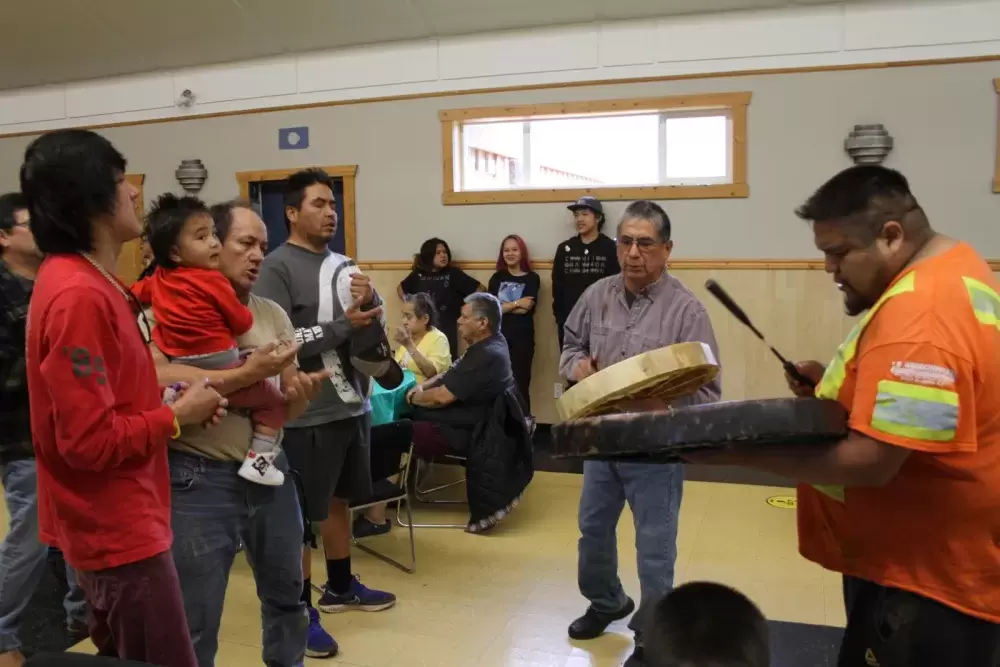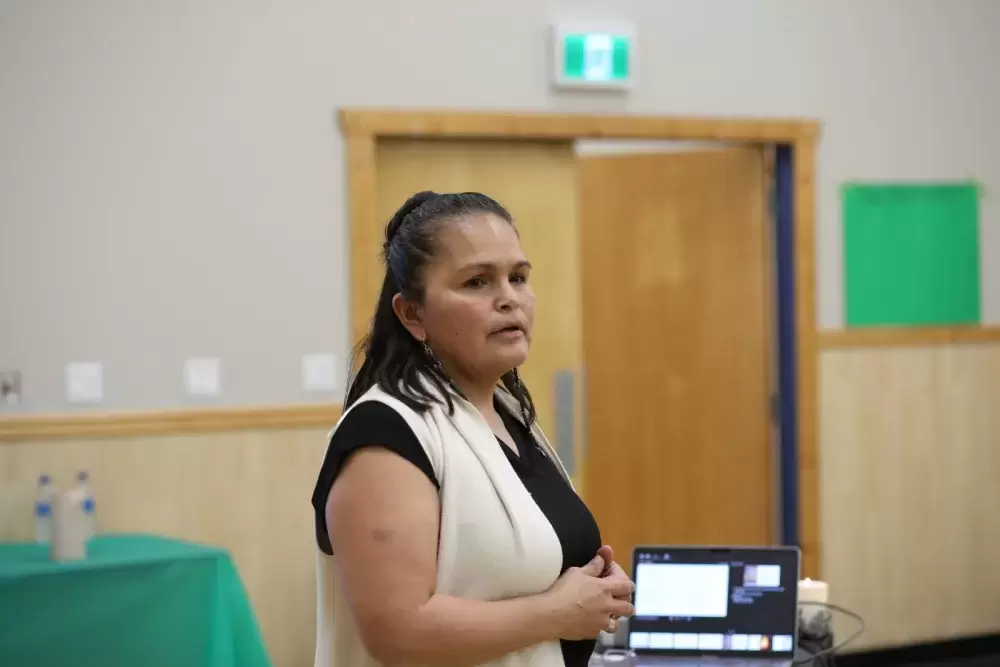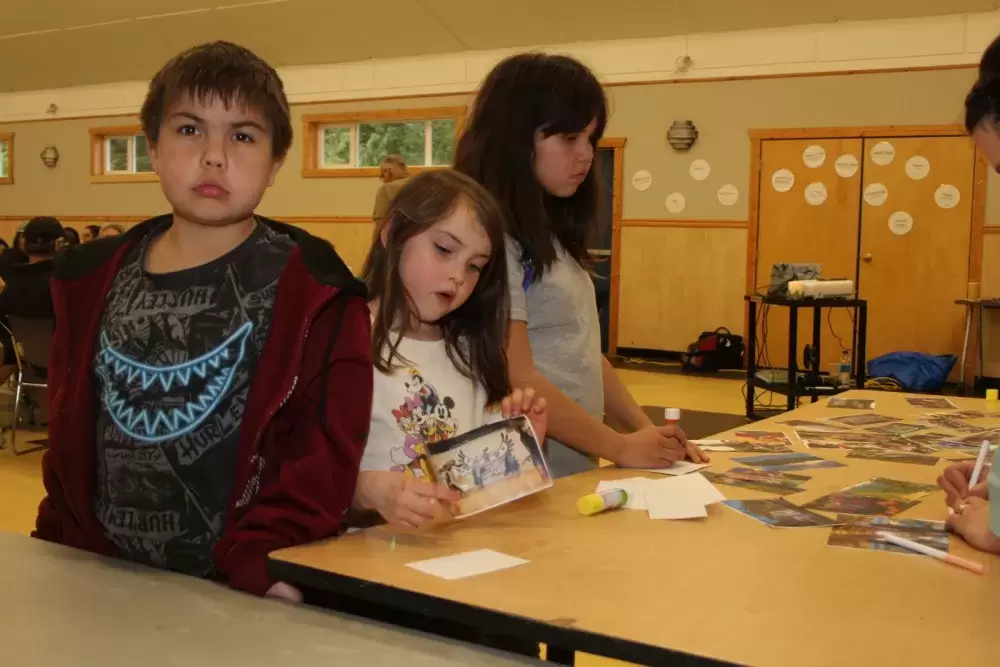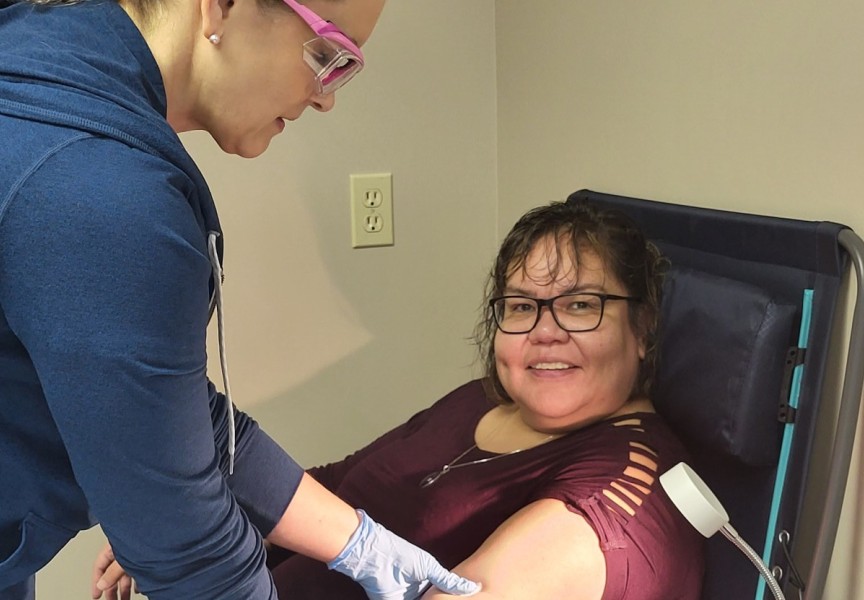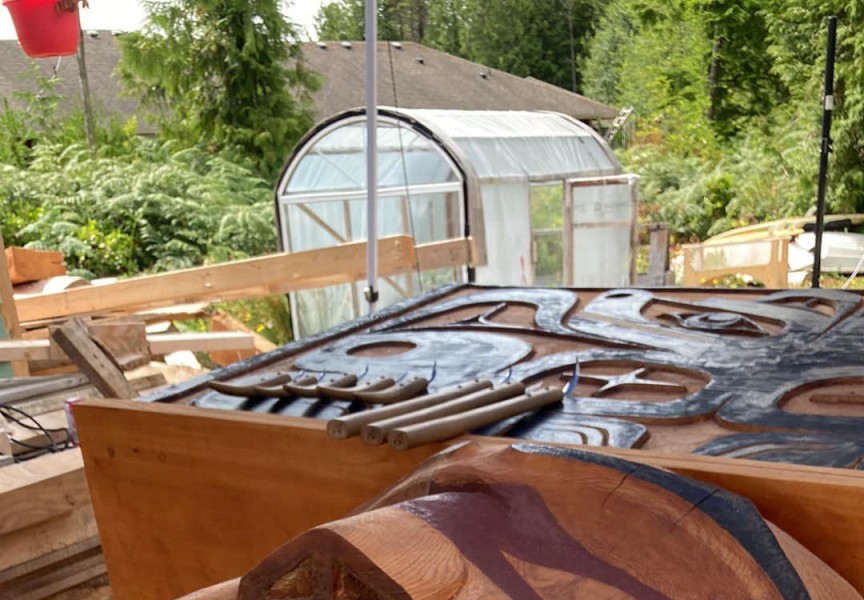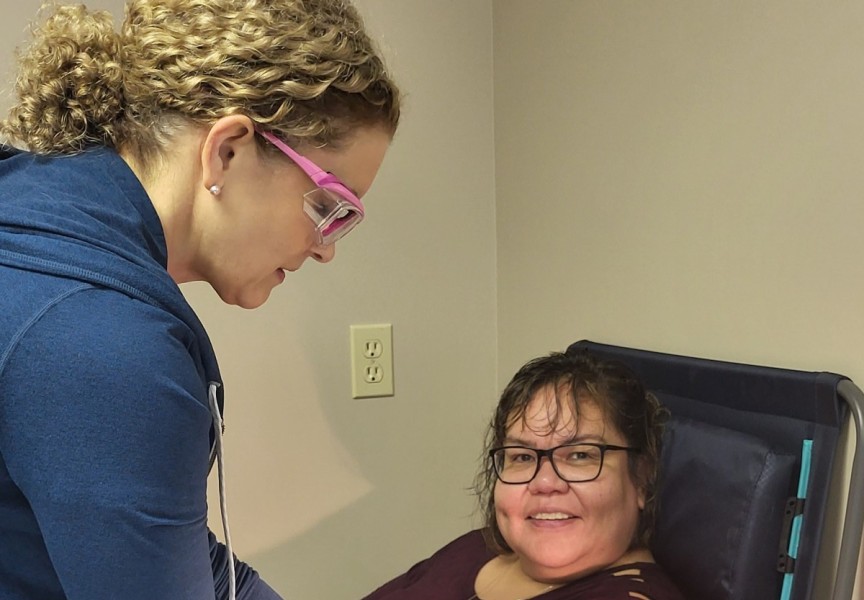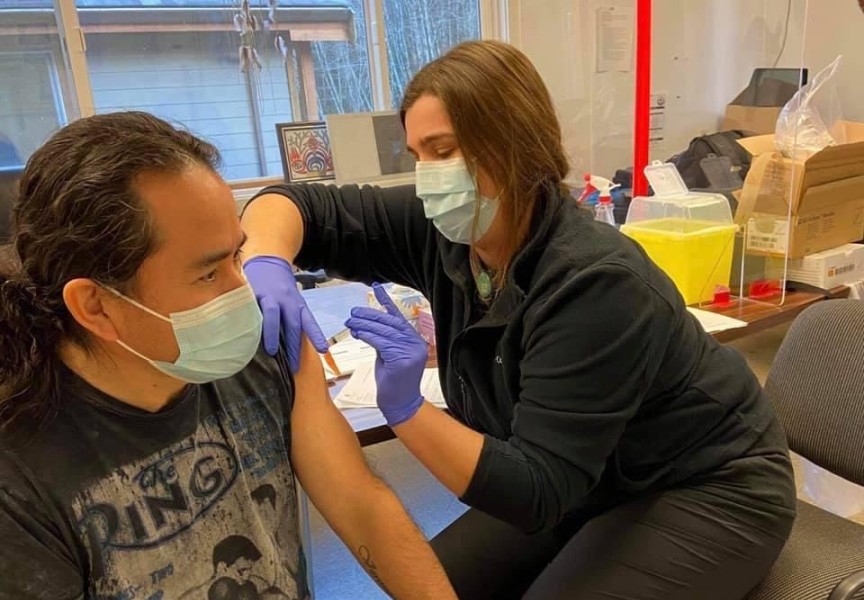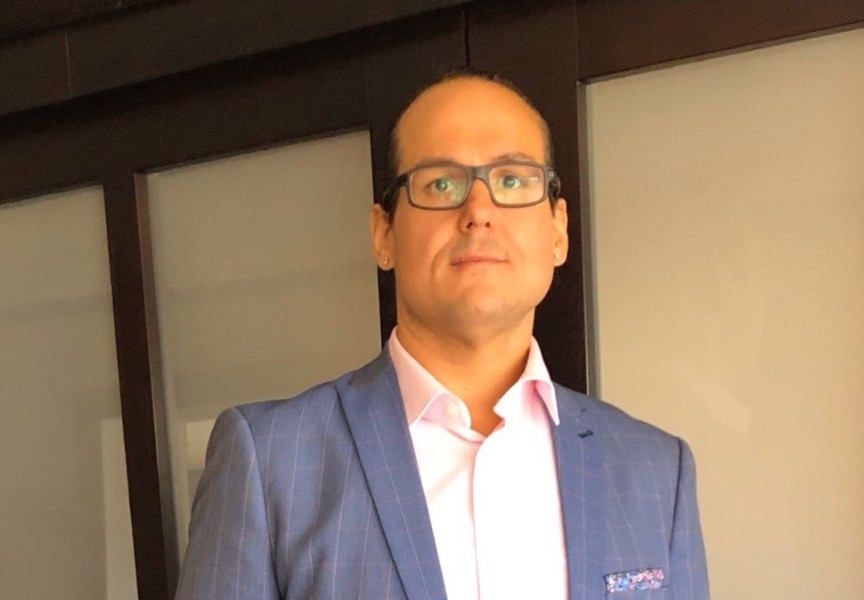“Connection is the correction” was the prevailing belief during a gathering at Nitinaht Lake last month, an event held to help the village work through the aftermath of pandemic-era isolation – as well as the ongoing sense of disconnect that the village’s elders attribute to a technologically fixated modern world.
On April 25 sessions facilitated by Anita Charleson-Touchie were held at the Ditidaht Community School and the village’s main hall, delving into the importance of traditional Nuu-chah-nulth values as a Western capitalist culture continues to encroach on the First Nation’s remote settlement on southwestern Vancouver Island.
“What we’re working hard to do is rebuild our circle,” said Charleson-Touchie. “Connection is sacred.”
In her presentation she displayed a diagram of concentric circles, while explaining the meaning of the Nuu-chah-nulth phrase ‘Hišuk ma c̕awak’.
“That acknowledges that everything in our world, who we are as individuals, who we are as families, communities, culture, nature, the universe, we’re all connected,” she said to the several dozen in attendance. “And what happens in one part has a ripple effect on all the other parts.”
To encourage connection with what is meaningful, participants engaged in various exercises. Pictures of things like a waterfall, killer whales, the open ocean and women dancing in regalia were spread around the room so that people could walk to what imagery attracted them. On paper paddles each participant wrote their values, producing things like “sense of belonging”, “ocean resources”, “traditional food” and “respectful coexistence”.
Charleson-Touchie also included a quote from the late Roy Haiyupis to further illustrate the concept of an all-encompassing connectedness.
“A common belief is that we are all endowed with the gift of life from the creator. We believe that the creator lives on the hills and the land; the creator also lives under the water, the rivers, lakes and oceans,” stated Haiyupis “As human beings, we are to form balance with this life that lives around us in nature.’”
Although these concepts of connectedness are commonly heard in Nuu-chah-nulth circles, the societal effects of COVID-19 restrictions made connection an inherent challenge during the pandemic. For those in the Ditidaht First Nation community, a hospital visit is at least an hour and a half away via a logging road, a remoteness that heightened concerns of coronavirus infection for residents.
“We were completely locked down,” said Tina Joseph, the Ditidaht Community School’s language and culture department coordinator. “There was only allowed one person per household to leave to do the grocery shopping. We had additional restrictions in place, other than provincial and federal. It was a bit tense.”
While COVID-19 restrictions have been lifted, the toll of the two years of strict measures continues to affect many families in the community.
“It’s been challenging to get community together, even for larger functions and events,” said Joseph. “It hasn’t been until very recently that we’ve had numbers rising and seeing all different parts of community members coming out again. Tonight was good example of that.”
Esther Edgar believes that the session was what the Ditidaht community has been yearning for.
“The pandemic had a big impact on my grandchildren,” said Edgar, who lived in Nitinaht Narrows as a child, a part of the several tribal groups that amalgamated in 1967 to form the current reserve community by Nitinaht Lake, she explained. “They don’t know what it’s like to have to pack water, collect driftwood, eat off the land. They think food is chicken strips and fries, we never had that. We had mussels, gooseneck barnacles, tutsup.”
As a child Edgar recalls the novelty of soda pop. Her father, who worked in a logging camp, would barter smoked fish for Coke of Orange Crush.
“We had maybe two bottles of pop a year, and as a family passed it around,” she recalled. “We would all take a sip and pass it to the next person.”
Edgar learned the Ditidaht dialect from her grandparents, who didn’t speak English. She reflects that the societal transformation into Canada’s modernity – and all its associated technology – has undermined the role of grandparents.
“Grandparents now don’t have the ability to be grandparents the way my grandparents were,” said Edgar. “Technology. Children are busy doing whatever they’re doing from the time they’re three or four years old. Parents aren’t the way they used to be. They’re not disciplined the way I was.”
“I was corrected by all the people in the community when I was a kid, not just my parents and grandparents,” she added.
In recent years governments have stressed the need to improve telecommunications infrastructure for remote First Nations. In March 2022 the federal and provincial governments announced a plan to connect 98 per cent of Canadians with high-speed internet by 2026, and 100 per cent four years later. In British Columbia this will be accomplished through an investment of up to $830 million from the governments to improve internet in remote communities.
“We need to close the connection gap and ensure that every nook and cranny of British Columbia has access to reliable high-speed internet,” stated Gudie Hutchings, Canada’s minister of Rural Economic Development.
Nitinaht Lake is still without cell phone coverage, but Wi-Fi can be available in the community. Meanwhile, something is being lost in this process, said Perry Edgar, who has lived at Nitinaht since the mid 1980s.
“It’s a distraction from the fundamentals of life,” said Perry in his assessment of Wi-Fi technology and all of its accompanying devices.
Perry hopes to see more gatherings that draw a diverse portion of the community. He recalls the dance practices that were regularly held in the ‘80s in a gym that stood where Nitinaht’s clinic is now.
“I loved the community when it was a community, not a divided nation,” he said. “I say divided because all the families don’t gather like this.”
“This gathering could be opening a door to becoming a better community, to communicate with the older generation, with the younger generation,” added Esther.
“I think that we’re now starting to come back together as a community after the pandemic, and just focusing on our values to continue bringing us back together was the intent of this,” said Joseph. “We’re a part of our community, but we also have responsibilities - whether they be cultural, different portions of leadership, just supporting community in general. We’re all responsible for that.”
“Hišuk nish c̕awak, I am one with everything,” explained Charleson-Touchie. “That means that I have a responsibility to take care of everything around me.”

